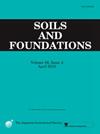砂土小尺度冻结取样方法的室内试验研究
IF 3.3
2区 工程技术
Q2 ENGINEERING, GEOLOGICAL
引用次数: 0
摘要
在实验室测试中,需要收集高质量的原状样品来准确地测定沙土的原位液化阻力,这一点已得到广泛认识。几十年前,冻结取样法是通过对地面进行预冻结来减少取样扰动而发展起来的。但由于工程规模大、成本高,在普通岩土工程勘察中很少采用该方法。为了解决这一问题,最近开发了一种小规模冷冻取样方法。它减少了采样时间和所需冷却剂的量,可以应用于常规的井眼测量。另一方面,用这种新方法采集的样品的质量还没有得到适当的评价。因此,本研究探讨了利用圆柱形砂柱插入冷冻管的适宜条件,并在校准室中成功实施了小规模冷冻取样方法,在大约40分钟内收集了外径为100 mm的空心圆柱形冷冻样品,仅使用了约70 kg的液氮。冰冻样品的质量评价重点放在密度和横波速度的测量上。结果表明,取样前后的小应变剪切模量变化幅度为- 0.5%,表明实施小规模冻结取样有望提高现场液化阻力估算的准确性,进而提高液化评估的准确性。本文章由计算机程序翻译,如有差异,请以英文原文为准。
Laboratory experiments on small-scale freezing sampling method for sand
The need to collect high-quality undisturbed samples to accurately determine in-situ liquefaction resistance of sandy soils in laboratory tests is widely recognized. Decades ago, the freezing sampling method was developed to minimize sample disturbance by pre-freezing the ground. However, due to the large scale and high cost of the work, this method is rarely used in common geotechnical surveys. To address this issue, a small-scale freezing sampling method has recently been developed. It reduces the sampling time and amount of required coolant, and can be applied to conventional borehole surveys. On the other hand, the quality of the samples collected by this new method has not been properly assessed. In this study, therefore, the appropriate conditions for inserting the freezing tube with the help of a cylindrical sand column were discussed, and the small-scale freezing sampling method was successfully implemented in a calibration chamber, whereby hollow cylindrical frozen samples with an outer diameter of 100 mm were collected within approximately 40 min and using only about 70 kg of liquid nitrogen. The focus of the quality assessments of the collected frozen samples was placed on the density and shear wave velocity measurements. The results showed that the changes in the small strain shear moduli were −0.5 % between the stages before and after the sampling, suggesting that the implementation of small-scale freezing sampling can be expected to improve the accuracy of in-situ liquefaction resistance estimates and, in turn, the accuracy of liquefaction assessments.
求助全文
通过发布文献求助,成功后即可免费获取论文全文。
去求助
来源期刊

Soils and Foundations
工程技术-地球科学综合
CiteScore
6.40
自引率
8.10%
发文量
99
审稿时长
5 months
期刊介绍:
Soils and Foundations is one of the leading journals in the field of soil mechanics and geotechnical engineering. It is the official journal of the Japanese Geotechnical Society (JGS)., The journal publishes a variety of original research paper, technical reports, technical notes, as well as the state-of-the-art reports upon invitation by the Editor, in the fields of soil and rock mechanics, geotechnical engineering, and environmental geotechnics. Since the publication of Volume 1, No.1 issue in June 1960, Soils and Foundations will celebrate the 60th anniversary in the year of 2020.
Soils and Foundations welcomes theoretical as well as practical work associated with the aforementioned field(s). Case studies that describe the original and interdisciplinary work applicable to geotechnical engineering are particularly encouraged. Discussions to each of the published articles are also welcomed in order to provide an avenue in which opinions of peers may be fed back or exchanged. In providing latest expertise on a specific topic, one issue out of six per year on average was allocated to include selected papers from the International Symposia which were held in Japan as well as overseas.
 求助内容:
求助内容: 应助结果提醒方式:
应助结果提醒方式:


